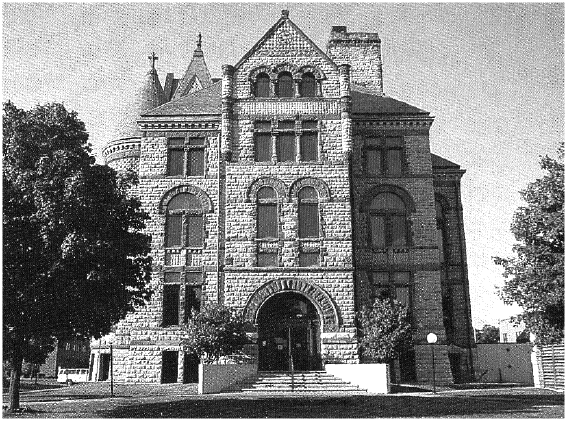
Courthouses of Minnesota
Mary Logue
Doug Ohman
Photographer
(Minnesota Historical Society)

The Wright County Courthouse looks to be an oversized gas station or parking garage --- presumably, criminals do get parked there for a while. St. Louis County (Duluth) resembles a 1930s WPA post-office. Maybe it is a 1930s WPA post-office. Todd County Courthouse appears to be an oversized (and prosperous) farm-house. Lake County's is a Greek Temple (to the goddess Nemesis, perhaps), Lac qui Parie ("she who prays") has a red brick school-house, and Isanti's looks to be a ticket office for the Duluth County regional airport. Red Lake's is a early 20th Century power plant, and Wadena County offers, over the entryway, two spring-boards so you can dive into the near-by parking lot.The Stearns County Courthouse appears to be modeled on the U. S. Mint, implying, perhaps, that guilt and gilt go hand-in-hand. Winona County's Romanesque is a beaut [See Fig. 1 above], and Pipestone County's reminds me of my old college dorm --- I suspect it's just as uncomfortable and drafty, but I doubt if the inhabitants drop cherry-bombs in the flush toilets on drunken Saturday nights.
The newest Stevens County Courthouse is a Chicken-of-the-Sea tuna-packing plant. McCloud County's resembles our old Armory, and Lyon County's presents a large can of Campbell's Tomato Soup as a porte cochère.
Some are beautiful, some are terrible --- but they represent to most people not the glories of Romanesque or Classical Revival (or the brute force of New Brutalism or the iciness of the International School of architecture), but hours of sitting in dingy rooms, learning that the wheels of justice grind exceedingly fine, and exceedingly slow --- listening to lawyers drone and bailiffs snore and the poor and the ignorant trying to tell their story, knowing that under the arcane rules that run American justice, they might well be getting screwed.
Some of these places look spooky, but Minnesota figured out a hundred years ago that capital punishment didn't do squat for the murder rate. Frying people, or asphyxiating them at the business end of a rope, or having local physicians test their consciences and the limits of "Primum non nocere" seems to have the reverse effect. The Death Penalty Information Center reports that over the last ten years,
As executions rose, states without the death penalty fared much better than states with the death penalty in reducing their murder rates. The gap between the murder rate in death penalty states and the non-death penalty states grew larger. In 1990, the murder rates in these two groups were 4% apart. By 2000, the murder rate in the death penalty states was 35% higher than the rate in states without the death penalty. In 2001, the gap between non-death penalty states and states with the death penalty again grew, reaching 37%.
Mary Logue who writes the not-uninteresting commentary for Courthouses of Minnesota with its 100 or so photographs, has a personal take on capital punishment. In 1979, her sister was murdered. In 1980, she assisted the police investigation. She remembers sitting for hours in a windowless room, waiting to testify. After the verdict, she learned that the supposed murderer claimed that it was not him, but a friend who had committed the murder.
I asked what I should do. The detective said my name, then said, "It's over. The jury has decided. He's going to jail." And in that moment, I saw it was out of my hands. The state had decided.
--- Alan Comfort